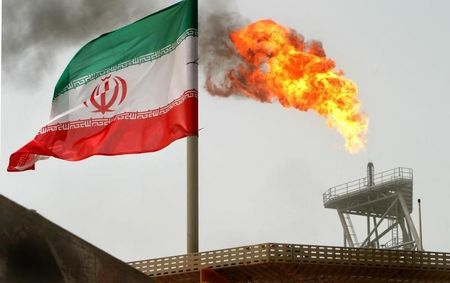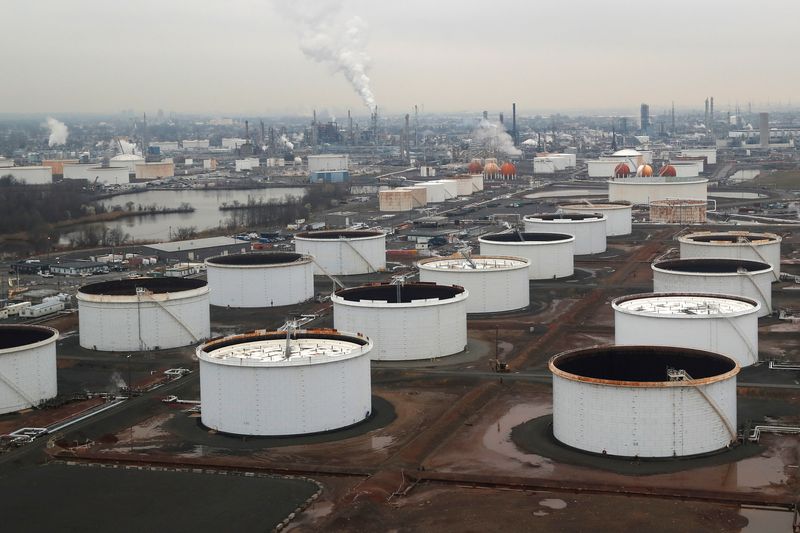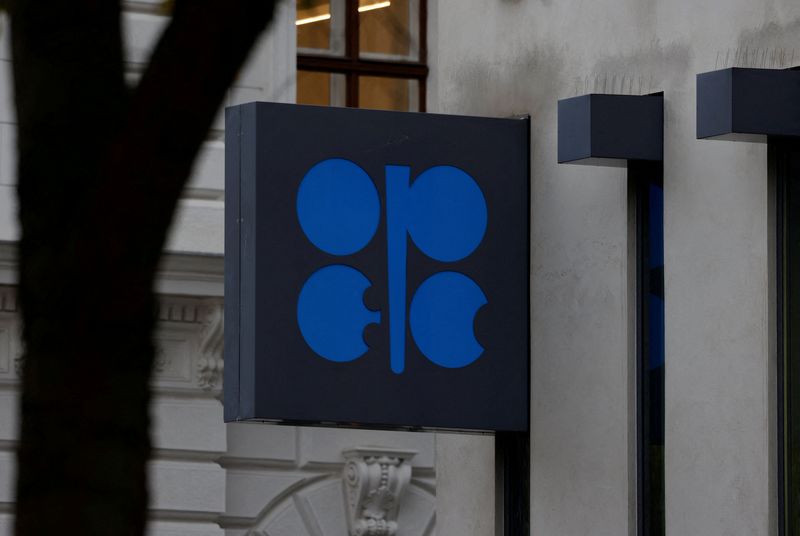Commodities
Oil prices retreat after early sharp gains; Goldman lifts forecasts

Investing.com– Oil prices fell Friday, handing back the earlier sharp gains after Israel reported launched strikes against Iran, elevating the already fraught tensions in the Middle East.
At 08:50 ET (12:50 GMT), fell 0.5% to $86.65 a barrel, while dropped 0.3% to $82.47 a barrel.
Middle East tensions back in focus after Iran explosions
Both benchmarks had soared 3% earlier Friday after reports of missile strikes in Iran, with Iran’s Fars News Agency saying explosions were heard in Isfahan in central Iran, in parts of southern Syria and in parts of Iraq. ABC news reported that U.S. officials said Israel had retaliated against Iran.
Both contracts reversed a bulk of their losses for the week, but were still set to end the week mildly negative.
Israel’s likely retaliation, around a week after Iran launched a missile and drone strike against Israel last week, which was in turn retaliation for an alleged Israeli strike on an embassy in Damascus, marks an escalation in the Middle East conflict.
That said, the quick surrender of early gains suggests the market doesn’t believe this to be a severe escalation, with Tehran stating that nuclear facilities were undamaged.
Iran recently said it could reconsider developing a nuclear weapon if Israel attacked the country’s nuclear sites, which it said have so far been used only for peaceful, power-generating purposes.
UN reports recently showed Iran was enriching uranium up to 60%, which was more than levels required for commercial power generation. But it was also below the 90% enrichment level required for an atomic bomb.
Goldman lifts oil forecasts
“After rallying sharply to just over $90/bbl on rising geopolitical risks, Brent prices have declined to $87/bbl,” said analysts at Goldman Sachs, in a note.
“We still see a $90/bbl ceiling on Brent in our base case of non geopolitical supply hits,” the influential investment bank said. “The reasons are that high spare capacity and higher prices will likely lead OPEC+ to raise production in Q3, inventories remain flat over the past year, and prices are already triggering stabilizing responses, including rises in OPEC exports and lower crude demand from the US SPR and refineries.”
That said, the bank lifts its floor for Brent to $75 a barrel, from $70, saying it assumes only a gradual normalization in the risk premium, and think that OPEC will manage to keep spot prices above long-dated prices through a smaller unwind of production cuts than we assumed before.
Additionally, “we still see value in long oil positions given significant portfolio hedging benefits against geopolitical shocks, and an attractive 10% annualized roll yield.”
It also lifts its Brent forecast to $86 a barrel for the second half of 2024, versus $85 prior, and to $82 a barrel for 2025, from $80.
Oil still set for weekly losses
Oil prices are set for hefty weekly falls, on the back of a stronger , following strong U.S. economic data and warnings from a slew of Fed officials that interest rates will remain higher for longer.
A stronger dollar pressures crude demand by adding a currency-related premium for international buyers.
The prospect of higher-for-longer rates factors into fears that global economic growth will be stymied by tight policy, which also bodes poorly for oil demand.
Traders were seen largely pricing out expectations for a June rate cut by the Fed.
(Ambar Warrick contributed to this article.)
Commodities
Oil prices rebound after closing at seven-week low

By Robert Harvey and Deep Kaushik Vakil
LONDON (Reuters) -Oil prices rose on Thursday, rebounding from three days of losses that took prices to their lowest since mid-March.
futures for July gained 58 cents, or 0.7%, to $84.02 a barrel by 1130 GMT. U.S. West Texas Intermediate (WTI) crude for June was up 47 cents, or 0.6%, at $79.47.
Prices fell more than 3% to a seven-week low on Wednesday after the U.S. Federal Reserve kept interest rates steady and warned of stubborn inflation, which could curtail economic growth this year and limit oil demand increases.
Crude was also pressured by an unexpected increase in inventories in data from the Energy Information Administration (EIA). Inventories were shown at their highest since June. [EIA/S]
Crude inventories rose by 7.3 million barrels to 460.9 million barrels in the week ended April 26, compared with the 1.1 million barrel draw expected by analysts in a Reuters poll.
While OPEC and its allies have yet to begin formal talks on extending voluntary oil output cuts beyond June, three sources from OPEC+ producers said such an extension could be agreed if demand fails to pick up.
“However, with 2025 oil balances looking in greater surplus due to non-OPEC+ supply growing faster than demand, we think OPEC+ should feel increasing pressure to unwind cuts going into next year,” Citi analysts said in a note late on Wednesday.
Supporting the price recovery was the potential for lower prices to spur U.S. government buying for strategic reserves.
remove ads
.
“The oil market was supported by speculation that if WTI falls below $79, the U.S. will move to build up its strategic reserves,” said Hiroyuki Kikukawa, president of NS Trading.
The U.S. has previously said it aims to replenish the Strategic Petroleum Reserve (SPR) after a historic sale from the emergency stockpile in 2022 and wants to buy back oil at $79 a barrel or less.
In the Middle East, meanwhile, expectations grew that a ceasefire agreement between Israel and Hamas could be in sight after a renewed push led by Egypt.
A deal on that front could take out some of the geopolitical risk premium that has buoyed oil prices in recent months, though Israeli Prime Minister Benjamin Netanyahu has vowed to proceed with a long-promised assault on the southern Gaza city of Rafah.
“The geopolitical temperature might have dropped a notch or two, but the climate remains hot,” said PVM analyst Tamas Varga.
Commodities
OPEC+ could extend oil cuts, formal talks yet to start, sources say

By Alex Lawler and Olesya Astakhova
LONDON/MOSCOW (Reuters) – OPEC and its allies have yet to begin formal talks on extending voluntary oil output cuts of 2.2 million barrels per day beyond June, but three sources from OPEC+ producers said they could keep their cuts if demand fails to pick up.
OPEC+ has implemented a series of output cuts since late 2022 amid rising output from the United States and other non-member producers, and worries over demand as major economies grapple with high interest rates.
OPEC+, which includes the Organization of the Petroleum Exporting Countries, Russia and other non-OPEC producers, next meets on June 1 in Vienna to set output policy. OPEC did not respond to a request for comment.
The OPEC+ group is currently cutting output by 5.86 million bpd, equal to about 5.7% of global demand. The cuts include 3.66 million bpd by OPEC+ members valid through to the end of 2024, and 2.2 million bpd of voluntary cuts by some members expiring at the end of June.
Oil prices have found support this year from the conflict in the Middle East, although concern about economic growth and high interest rates has weighed. hit a seven-week low on Wednesday and settled at $83.44 a barrel.
The three sources from countries which have made voluntary supply cuts said an extension was likely.
The cuts could be extended until year-end, said one source, while another said it would take a surprise jump in demand for OPEC+ to make any changes.
remove ads
.
Two other OPEC+ sources said formal talks had yet to take place, and one of those said OPEC+ was not yet leaning one way or the other on extending cuts.
The countries which have made voluntary cuts that are deeper than those agreed with the wider group are Algeria, Iraq, Kazakhstan, Kuwait, Oman, Russia, Saudi Arabia and the United Arab Emirates.
“We think there’s a good chance that OPEC+ will extend beyond June – but we aren’t yet putting a firm view because we don’t think they’ve actually got into the real period of discussion and decision-making,” said Richard Bronze of Energy Aspects.
Another option would be for some or all of the 2.2 million bpd of cuts to be unwound after June, analysts say.
OPEC has said it expects another year of relatively strong oil demand growth of 2.25 million bpd, while the International Energy Agency expects much slower growth of 1.2 million bpd.
Commodities
Oil prices rise on talk of extended OPEC+ supply cuts

Investing.com– Oil prices rose Thursday, recovering from near two-month lows, helped by talk of an extension of OPEC+ supply cuts.
At 08:20 ET (12:20 GMT), rose 1% to $84.28 a barrel, after hitting a seven-week low on Wednesday, while rose 0.9% to $79.73 a barrel.
OPEC+ to extend cuts?
OPEC and its allies could yet extend their voluntary oil output cuts of 2.2 million barrels per day beyond June, but Reuters reported Thursday, citing sources.
OPEC+, which includes the Organization of the Petroleum Exporting Countries, Russia and other non-OPEC producers, next meets at the start of June 1, and has yet to start formal talks, the news agency said, but the spurces indicated they could keep their cuts if demand fails to pick up.
The group has implemented a series of output cuts since late 2022 amid rising output from the United States and other non-member producers, and worries over demand as major economies grapple with high interest rates.
It is currently cutting output by 5.86 million barrels per day, equal to about 5.7% of global demand, but just over 2 million barrels per day of voluntary cuts by some members expire at the end of June.
Dollar drops as Fed downplays rate hike speculation
Oil prices were helped earlier Thursday by a drop in the dollar, with the greenback falling back from near six-month highs on Wednesday after Federal Reserve Chair Jerome Powell said the central bank’s next rate move will likely be a cut, although the timing of such a move remained uncertain.
remove ads
.
Crude, like many commodities, is priced in dollars, and thus a weaker greenback benefits crude demand by making oil cheaper for international buyers.
Oil prices battered by US inventories, production spike
Crude markets are on course for hefty losses this week, after official data on Wednesday showed U.S. grew a substantially bigger-than-expected 7.3 million barrels in the week to April 26. Gasoline stockpiles also grew, while distillates had a minimal draw.
The inventory reading, which was preceded by data showing U.S. production surged past 13 million barrels per day in March, ramped up bets that oil markets were not as tight as initially thought.
Such a scenario bodes poorly for oil prices.
Middling purchasing managers index readings from top importer China also weighed on oil prices this week.
Focus was also on ceasefire talks between Israel and Hamas, with any progress on that front lowering the risk premium attached to oil markets.
(Ambar Warrick contributed to this article.)

 Forex2 years ago
Forex2 years agoForex Today: the dollar is gaining strength amid gloomy sentiment at the start of the Fed’s week

 Forex2 years ago
Forex2 years agoHow is the Australian dollar doing today?

 Forex1 year ago
Forex1 year agoUnbiased review of Pocket Option broker

 Forex2 years ago
Forex2 years agoDollar to pound sterling exchange rate today: Pound plummeted to its lowest since 1985

 Cryptocurrency2 years ago
Cryptocurrency2 years agoWhat happened in the crypto market – current events today

 World2 years ago
World2 years agoWhy are modern video games an art form?

 Stock Markets2 years ago
Stock Markets2 years agoMorgan Stanley: bear market rally to continue

 Economy2 years ago
Economy2 years agoCrude oil tankers double in price due to EU anti-Russian sanctions

































